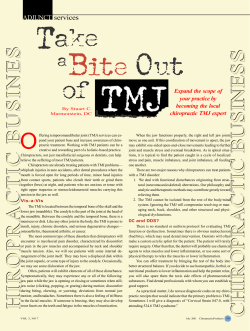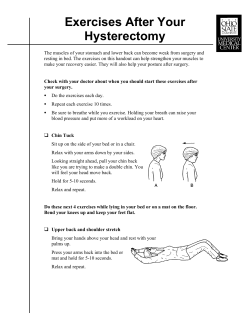
TMJ Exercises Specialist Surgery Information for patients
Oxford University Hospitals NHS Trust Specialist Surgery TMJ Exercises Information for patients What is the Temporomandibular Joint? The temporomandibular joint (TMJ) is located in front of the ear where the skull and lower jaw meet. It allows the lower jaw (mandible) to move. The TMJ is a hinge and gliding joint and is the most constantly used joint in the body. The round upper end of the lower jaw, or the movable portion of the joint, is called the condyle; the socket is called the articular fossa. Between the condyle and the fossa is a disk made of cartilage that acts as a cushion to absorb stress and allow the condyle to move easily when the mouth opens and closes. If this joint doesn’t work effectively it is called TMJ dysfunction. What are the symptoms and causes of TMJ dysfunction? TMJ disorders are quite common and have a variety of symptoms. Patients may complain of earaches, headaches or difficulty opening their mouth. They may also complain of clicking or grating sounds in the joint and feel pain when opening and closing their mouth. The causes of TMJ are varied. Arthritis is one cause of TMJ symptoms. Sometimes it is the result of an injury or from grinding the teeth at night. Another common cause involves displacement or dislocation of the disk that is located between the jawbone and the socket. A displaced disk may produce clicking or popping sounds, limit jaw movement and cause pain when opening and closing the mouth. The disk can also develop a hole or perforation, which can produce a grating sound with joint movement. There are also conditions such as trauma or rheumatoid arthritis that can cause the parts of the TMJ to fuse, preventing jaw movement altogether. What can I do to help improve the dysfunction and ease the pain? There are a number of things you can do to improve the function of the TMJ and ease the pain: • massaging your muscles • avoiding foods that are hard to chew • exercises to relax your jaw and face • practicing good posture • using hot or cold packs on the face. Some doctors will prescribe anti-inflammatory medication that can bring down the swelling and help your jaws relax. In some instances TMJ treatment can involve wearing a mouth guard or splint, which helps if you clench your jaw or grind your teeth particularly at night. Exercises to improve jaw function The purpose of these exercises is to prevent clicking of the jaw joint and to strengthen the muscles which pull the jaw backwards. This will relax the muscles which close the mouth, and will prevent those muscles which pull the jaw forwards and from side to side from functioning. The jaw will act more like a hinge and this will take the strain off it. As an addition to TMJ exercises, some doctors prescribe antiinflammatory medicines. Exercises Set aside two five minute periods each day at a time when you are relaxed – e.g. just before you get up or go to bed. Sit upright in a chair to perform all the following manoeuvres: 1.Close your mouth and make sure your teeth are touching but do not ‘clench’ you teeth, resting the tip of your tongue on your palate just behind the upper front teeth. 2.Run the tip of your tongue backwards towards your soft palate as far back as it will go, keep your teeth together. 3.Force your tongue back to maintain contact with the soft palate and slowly open your moth until you feel your tongue being pulled away. Do not open your mouth any further. Stay in this position for five seconds then close your mouth and relax. 4.Repeat this whole procedure slowly but firmly for the next 5 minutes. As you open your mouth you should feel the tension in the back of your neck and under your chin. The first few times you perform the exercise do it while checking in a mirror that the teeth move vertically downwards and do not deviate to either side. If the exercise is being performed correctly there will be no clicks or noise from the joints. If there is, re-start the exercise and continue practicing until it is click-free. Do not do this exercise more than recommended for the first week – five minutes, twice a day, for a week. Thereafter, do the exercises as often as you can. This will help strengthen the ligaments around your jaw and relax the muscles which close your mouth. You may find the pain is worse for a while at first; this is because you are unaccustomed to the movement – over time this will subside. After 2-3 weeks of doing the exercises you will find that the muscles will be retrained and your jaw will open and close smoothly without any clicking. Remember: • Never bite your finger nails • Never bite your lower lip • Avoid biting on your front teeth • Keep your upper and lower teeth apart when at rest. How to contact us If you have any questions or concerns, you may speak to a nurse on: Tel: 01865 231182 or speak to your GP. If you need an interpreter or need a document in another language, large print, Braille or audio version, please call 01865 221473 or email PALSJR@ouh.nhs.uk Elizabeth Lawson, Specialist Nurse Version 1, November 2011 Review: November 2014 Oxford University Hospitals NHS Trust Oxford OX3 9DU www.ouh.nhs.uk/patientinformation OMI 3525P
© Copyright 2025





















